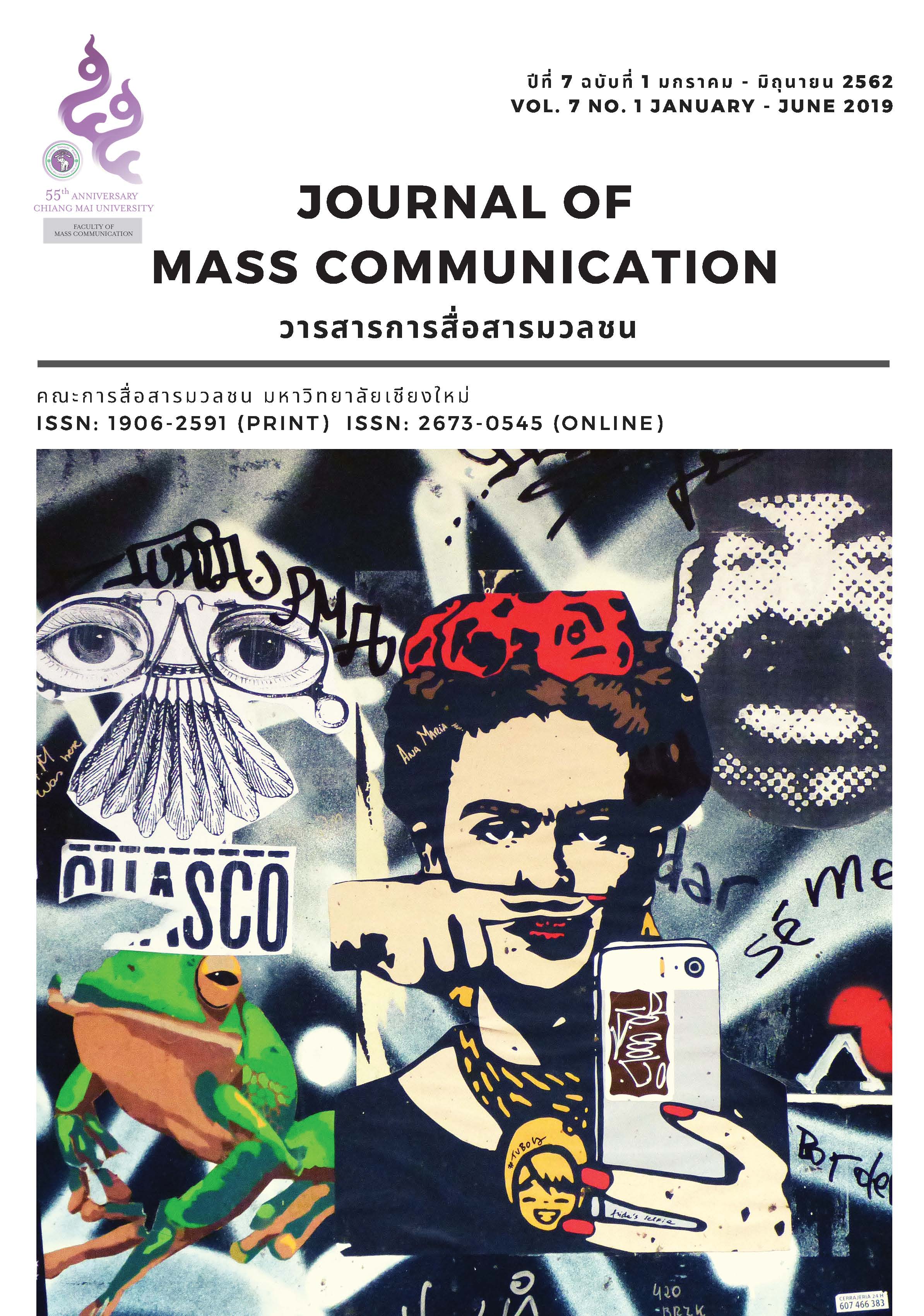การรู้เท่าทันสื่อของพระสงฆ์ในภาคเหนือของประเทศไทย
Main Article Content
บทคัดย่อ
พพระสงฆ์เป็นบุคลากรทางพระพุทธศาสนาที่เป็นส่วนหนึ่งของสังคมไทย มีบทบาทในการรับข้อมูลข่าวสารและสื่อสารข้อมูลข่าวสารให้กับชาวพุทธในสังคมระหว่างการปฏิบัติศาสนกิจเผยแผ่ศาสนา การรู้เท่าทันสื่อจึงเป็นทักษะให้พระสงฆ์สามารถรับและสื่อสารข้อมูล เนื้อหาต่างๆ ได้อย่างมีประสิทธิภาพ การวิจัยนี้ได้ศึกษาถึงการรู้เท่าทันสื่อของพระสงฆ์ และสามเณรในเขตภาคเหนือของประเทศไทย โดยใช้วิธีเชิงปริมาณ การวิเคราะห์กำหนดกลุ่มตัวแปรที่เกี่ยวข้องกับบริบทของพระสงฆ์เป็นสี่กลุ่มคือ ด้านอายุ ซึ่งรวมถึงอายุพรรษาของพระสงฆ์ สถานภาพความเป็นพระหรือสามเณร การศึกษาของพระสงฆ์ รูปแบบการเข้าถึงสื่อและลักษณะของการใช้สื่อของพระสงฆ์ ผลการวิจัยพบว่า การศึกษาทางโลกและความถี่ของการบริโภคสื่อจากอินเทอร์เน็ต เป็นตัวแปรสำคัญในการรู้เท่าทันสื่อ โดยพบว่า พระสงฆ์ที่มีการศึกษาทางโลกมาก มีการรู้เท่าทันสื่อสูง และพระสงฆ์ที่รับสื่อจากคอมพิวเตอร์หรืออินเทอร์เน็ตมากมีการรู้เท่าทันสื่อสูง
Article Details

This work is licensed under a Creative Commons Attribution-NonCommercial-NoDerivatives 4.0 International License.
ลิขสิทธ์ที่ผู้เขียนบทความต้องยอมรับ
References
จาก https://www.onab.go.th/
สำนักงานสถิติแห่งชาติ. (2555). การสำรวจสภาวะทางสังคมและวัฒนธรรม พ.ศ.2554. สืบค้นเมื่อ 11 กันยายน 2558,
จาก https://www.nso.go.th/
Aarsand, P., & Melander, H. (2016). Appropriation through guided participation: Media literacy in children ׳s everyday lives. Discourse, Context & Media, 12, 20-31. Retrieved from https://doi.org/10.1016/j.dcm.2016.03.002
Aczel, P. (2014). Reconceptualizing (new) media literacy. Perspectives of Innovations, Economics & Business, 14(1), 47-53. doi:10.15208/pieb.2014.06
Akti, S., & Gürol, A. (2012). Determining the relationship between media literacy and social skills. Procedia - Social and Behavioral Sciences, 64, 238-243. Retrieved from https://doi.org/10.1016/j.sbspro.2012.11.028
Diergarten, A. K., Möckel, T., Nieding, G., & Ohler, P. (2017). The impact of media literacy on children’s learning from films and hypermedia. Journal of Applied Developmental Psychology, 48, 33-41. Retrieved from https://doi.org/10.1016/j.appdev.2016.11.007
Flavell, J. H., Flavell, E. R., Green, F. L., & Korfmacher, J. E. (1990). Do young children think of television images as pictures or real objects?. Journal of Broadcasting and Electronic Media, 34(4), 399-419. Retrieved from https://dx.doi.org/10.1080/08838159009386752
Fletcher-Flinn, C. M., & Gravatt, B. (1995). The efficacy of computer assisted instruction (CAI): A meta-analysis.
Journal of Educational Computing Research, 12(3), 219-241. Retrieved from https://doi.org/10.2190/51D4-F6L3-JQHU-9M31
Harshman, J. (2018). Developing global citizenship through critical media literacy in the social studies. The Journal of Social Studies Research, 42(2), 107-117. Retrieved from https://doi.org/10.1016/j.jssr.2017.05.001
Kirkorian Heather, L., & Anderson Daniel, R. (2009). Learning from education media. The Handbook of Children, Media, and Development, 188-213. doi:10.1002/9781444302752.ch9
Kulthida, T., & Mega, S. (2017). The current state and influential factors in the development of digital literacy in Thailand’s higher education. Information and Learning Science, 118, 235-251. doi:10.1108/ILS-11-
2016-0076
Mares, M.-L., & Pan, Z. (2013). Effects of Sesame Street: A meta-analysis of children’s learning in 15 countries. Journal of Applied Developmental Psychology, 34(3), 140-151. Retrieved from https://doi.org/10.1016/j.appdev.2013.01.001
Mares, M.-L., Sivakumar, G., & Stephenson, L. (2015). From meta to micro: Examining the effectiveness of educational TV. American Behavioral Scientist advance online publication. 59(14), 1822-1846. Retrieved from https://dx.doi.org/10.1177/0002764215596555
Perryman, A. A., Fernando, G. D., & Tripathy, A. (2016). Do gender differences persist? An examination of gender diversity on firm per formance, risk, and executive compensation. Journal of Business Research, 69(2), 579-586. Retrieved from https://dx.doi.org/10.1016/j.jbusres.2015.05.013
Potter, W. J. (2010). The state of media literacy. Journal of Broadcasting & Electronic Media, 54(4), 675-696.
Retrieved from https://dx.doi.org/10.1080/08838151.2011.521462
Roblyer, M. D., Castine, W. H., & King, F. J. (1988). Assessing the impact of computer-based instruction: A review of recent research. New York: Haworth Press.
Rodloytuk, P. (2007). Buddhist participatory communication for rural development. The Journal of International Communication, 13(1), 119-136. doi:10.1080/13216597.2007.9674710
Suwana, F., & Lily. (2017). Empowering Indonesian women through building digital media literacy. Kasetsart Journal of Social Sciences, 38(3), 212-217. Retrieved from https://doi.org/10.1016/j.kjss.2016.10.004
Sweller, J. (1988). Cognitive load during problem solving: Effects on learning. Cognitive Science, 12(2), 257-285. Retrieved from https://doi.org/10.1207/s15516709cog1202_4
Şişman, B., & Yurttaş, Ö. U. (February 12, 2015). An empirical study on media literacy from the viewpoint of media. Procedia - Social and Behavioral Sciences, 174, 798-804. Retrieved from https://doi.org/10.1016/j.sbspro.2015.01.662
Zikmund, W. G. (2010). Business research methods. Mason, OH: South-Western Cengage Learning.

